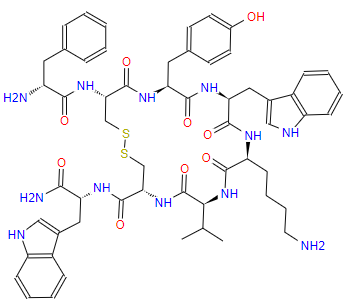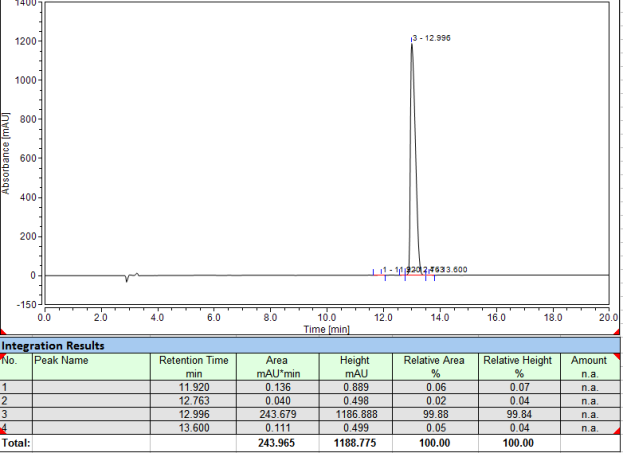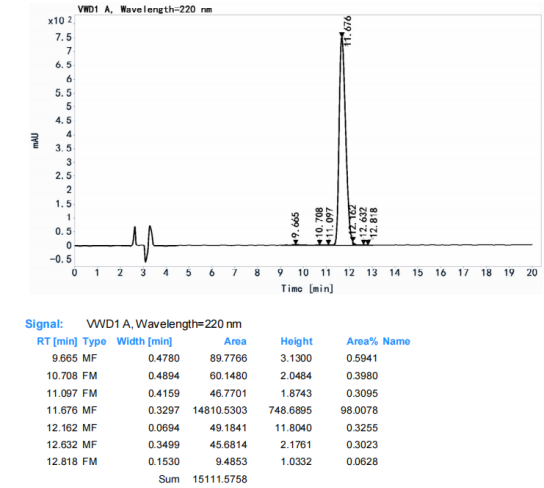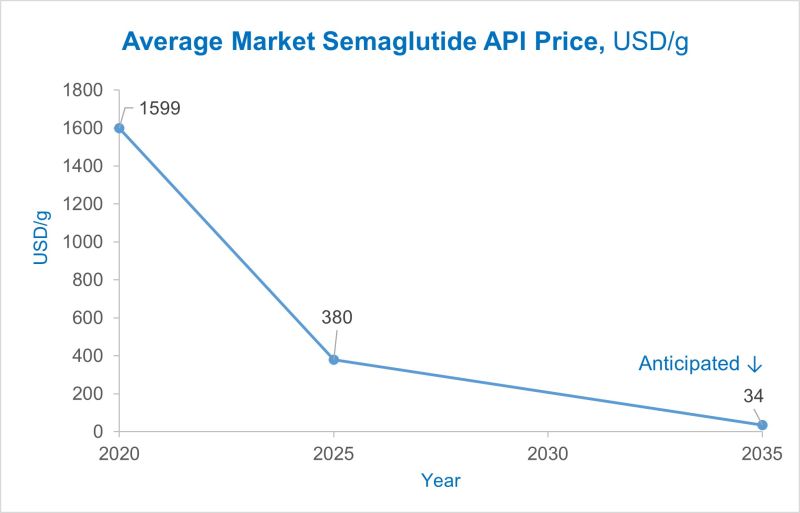Overview and application of valprotide acetate
Valprotide acetate is an artificially synthetic octapeptide somatostatin drug, which is clinically used for gastrointestinal bleeding, acromegaly, pancreatitis and other diseases, and also has a certain tumor inhibitory effect on neuroendocrine tumors, prostate cancer, etc. Therefore, using valprotide acetate as a template can improve the biocompatibility of precious metal nanomaterials. Valprotide acetate was approved for marketing in 2004 with the chemical name D-phenylalanyl-cysteine-tyrodyl-D-chromatoyl-lysazyl-valinel-cysteine-tryptamide-cyclo[2-7]-disulfide monoacetate.
Basic information:
Chinese name: valprotide acetate
English name: Vapreotide
Company number: GT-B016
CAS Number: 103222-11-3
Sequence: D-Phe-[Cys-Tyr-D-Trp-Lys-Val-Cys]-Trp-NH2
Formula: C57H70N12O9S2
Molecular weight: 1131.4
Physical and chemical properties
When valprotide acetate is dissolved in an acidic aqueous solution, it has a large positive charge on the surface because it is below its isoelectric point (pI≈10.0). In addition, because it is a small molecule compound composed of amino acids, the acidic environment will change the spatial conformation of the template, mainly manifested in α-helix and β-folding, etc., so that it can maintain a stable secondary and tertiary structure in aqueous solution for a long time. Similarly, when the valproptide acetate template is heat-treated at high temperature (≥70°C), its supersecondary structure (αα, βαβ, ββ) will change significantly, and the peptide chain forms a three-structure local fold area on the basis of the secondary structure or supersecondary structure, which is a relatively independent tight sphere, that is, the domain, which will also change due to changes in the environment. Of course, there are other means of processing peptide chains, such as heavy metal salts, ultrasound, etc. After the above acid and heat treatments, valprotide acetate will form a relatively stable three-dimensional structure, and the specific groups will be regularly exposed on the surface of the template. Therefore, when the metal salt solution is co-incubated with the pretreated Peptide acetate solution, the metal ions will bind to the surface of the template under the action of electrostatic forces and specific groups, and due to biomineralization, these attached ions will be reduced into trace small crystals, which we call "crystal seeds", and then under the action of suitable reducing agents, a large number of free metal ions are continuously reduced, and grow along one or several crystal planes of the "crystal seed", and finally form nanomaterials with the expected morphology.
Application
Vapapritide acid can be used as a biological template, and its advantages include: (1) small molecular weight, simple structure, and can be analyzed and designed according to the morphology of the intended material; (2) In acidic solution, the surface of vapritide acetate will carry a large amount of positive charge, and the precursor metal ions will be continuously adsorbed to the surface of the template through electrostatic force and specific groups, thereby increasing the metal load of nanomaterials and conducive to better their physical and chemical properties. (3) Valprotide acetate belongs to the somatostatin class, which has high biocompatibility, and the precious metal nanomaterials made from it as templates can be used in the field of physical medicine. Examples of its applications are as follows:
1) Preparation of a silver-gold alloy nanospherical shell based on valproptide acetate, It is mainly prepared according to the ratio of 0.91~1.13mg vapritide acetate per ml of hydrochloric acid solution, treated at 65~67°C for 20~24min, according to the ratio of 1:3~9, silver nitrate solution is added, put into a water bath constant temperature shaker at 24°C for 24~26h, according to the ratio of silver nitrate: sodium borohydride is 1:1~2, and then the reducing agent sodium borohydride is added drop by drop, and the reaction is 16~18min at 24°C; and then placed in a boiling water bath at 100°C for 10min, and gold trichloride solution is added according to the ratio of gold trichloride:silver nitrate molar ratio of 1:25~45 , 100°C boiling water bath for 2~4min, silver-gold alloy nanospheres with particle size of 90~110nm were prepared. The present invention is easy to control, simple to operate, green and environmentally friendly, mild reaction conditions, and the prepared silver-gold alloy has uniform particle size and good dispersion.
2) Preparation of palladium nanocubes. Valprotide acetate was dissolved in a hydrochloric acid solution with a pH of 1~3, A concentration of 0.1~0.2mM was prepared into 300μL vaprotide acetate solution, and the palladium chloride solution was added to the molar ratio of vaprotide acetate:palladium chloride at a ratio of 1:20~60, and placed in a constant temperature metal bath at 60~80°C. According to the molar ratio of palladium chloride:ascorbic acid was 1:10~50, the newly prepared ascorbic acid solution was quickly added for reduction, and the solution gradually changed from light yellow to black-brown, so as to obtain palladium nanocubes with regular morphology and uniform particle size. The preparation process of the present invention is simple and easy to operate; And this method does not use toxic reagents, which is green and environmentally friendly; The prepared palladium nanocubes have regular morphology, good photothermal conversion performance, and rapid heating after short-term low-power laser irradiation, which can be used as hyperthermic agents for cancer treatment.
3) Silver nanospheres were prepared with valprotide acetate as a biological template, It is mainly formulated into a vaprotide acetate solution with a concentration of 0.2~0.4mM, kept warm at 70~80°C for 10~30min, and the silver nitrate solution is added to the vapritide acetate solution at a ratio of 1:6~8, put into a water bath constant temperature shaker, 80~100rpm, 25°C for 12~24h, according to the molar ratio of silver nitrate solution: sodium borohydride is added to the incubated solution, the drop rate is 2 drops/minute, 60μL per drop, 25°C reaction for 5~15min, so as to obtain silver nanospherical shells with uniform particle size and good dispersion of 80~100nm. The silver nanosphere shell prepared by the invention overcomes the shortcomings of easy aggregation and precipitation in the traditional preparation process, and has a high metal load.
Anyone need customized peptides, plz contact haoran.tse@gmail.com
Telphone no: +8618575536586




